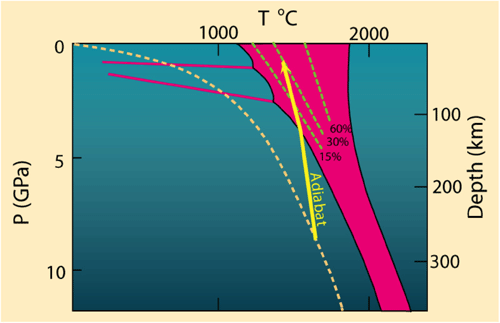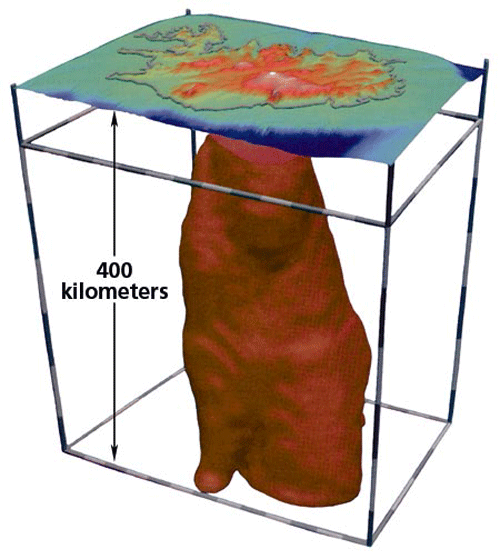In Module 1, we learned how the mantle sometimes melts as a result of a thermal anomaly (“hot spot”) that elevates the local geotherm above the mantle solidus. A close look at the diagonal orientation of the mantle solidus on a pressure-temperature diagram suggests that the mantle should also be able to melt under the influence of a pressure anomaly. That is, a rapid decrease in pressure can cause the mantle to melt, even without an increase in temperature. We call this kind of melting adiabatic – or, more commonly, decompression melting. Decompression melting commonly occurs at divergent plate boundaries, where two tectonic plates are moving away from each other. Mid-ocean ridges are the classic example, but adiabatic melting also occurs during continental lithospheric extension and in some mantle plumes.

Check Your Understanding
According to the diagram above, at approximately what depth does adiabatic melting begin?
Click for answer.
Melting begins where the adiabat intersects the solidus, at about 125 km depth.
Iceland is unique in that many researchers believe that a mantle plume is rising up through the Mid-Atlantic Ridge here. Thus melting at Iceland probably involves both high-temperature melting due to a thermal anomaly and decompression melting related to the divergent boundary. This may explain why eruption rates are so high (a significant eruption occurs once every 2-3 years), and why it is the only place on Earth where a mid-ocean ridge is exposed above sea level. The relative travel times of seismic waves beneath Iceland (seismic waves travel more slowly through hot or partially molten materials) have been used to map a narrow anomaly extending to at least 400 km depth, which many believe to be evidence of an Icelandic mantle plume. However, it is important to keep in mind that 400 km depth is still only the uppermost part of the asthenosphere, nowhere near the 2,900 km depth of the core-mantle boundary (which is generally believed to be the origin of hot mantle plumes). Some scientists believe that the plume does extend into the deep mantle, but cannot be imaged at depth because it is so narrow that it cannot be resolved using seismic imaging techniques.
